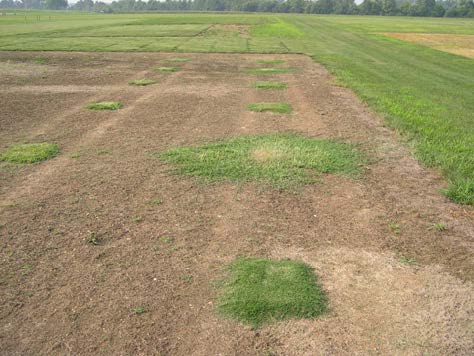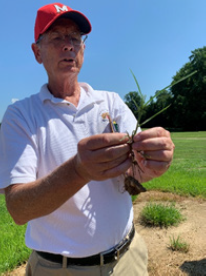Humid Temperate and Subtropical Turfgrass Species Growth in Maryland: A Living Lab for Students
Mark Carroll, Department of Plant Science and Landscape Architecture

As a member of the University of Maryland turfgrass team, and the instructor of the University of Maryland’s introductory turfgrass management
course, I am always mindful that a turf student may do an internship or relocate to another region of the country following graduation. As such, I dedicate equal amounts of time introducing students to turfgrass species that are common in mid-Atlantic region as well those that found in other regions of the country.
Several turfgrass species that are commonly found in the deep south, and coastal California, do not survive winters in the Mid-Atlantic. To show these grasses to students as they would appear in a lawn, samples of these species are maintained in a greenhouse from November to May after which, flats of each are planted in a field adjacent to the classroom at Paint Branch Turfgrass Facility. The grasses are spaced far enough apart from one another, that when they are viewed by students in September, they can see how the growth rates of the various species vary over the course of the summer. Visitors attending educational workshops at the facility over the summer months are also afforded the opportunity to view and learn about these turfgrass species. With the onset of freezing temperatures, the samples are dug up and placed back in the greenhouse where they remain until the following May.

Over the winter months, turf student teams that are preparing for the National Collegiate Turf Bowl and Student Challenge competitions, use the plant material to prepare for the turfgrass identification sections of these two competitions. The two competitions, which take place at the Golf Course Superintendents Association of America Conference and Trade Show, and the Sports Field Management Association Conference respectively, are intensively competitive events that can involve has many as 80 student teams from universities around the country. Under the direction of Dr. Kevin Mathias, and more recently Senior Lecturer Geoffrey Rhinehart, the University of Maryland teams have done very well in these competitions, including several first-place finishes over the past 10 years. I like to think the Humid Temperate and Subtropical Turfgrass Species Growth in Maryland: A Living Lab for Students, has played a small part in team’s successes.